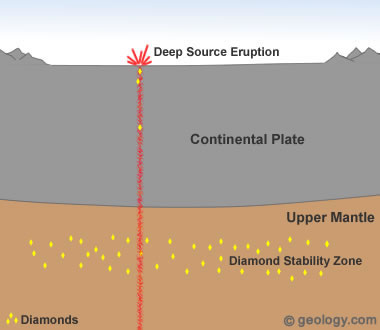Plumes from the Core-Mantle BoundaryWhile prospectors and geologists have been successful in finding
diamonds through diligent searching, one
University of Houston professor and his team's work could help improve
the odds by focusing future searches in particular areas.
Kevin Burke, professor of geology and tectonics at UH, and his fellow researchers describe these findings
in a paper titled "Diamonds Sampled by Plumes from the Core-Mantle Boundary," appearing July 15, 2010 in Nature,
the weekly scientific research journal.
Kimberlites and Mantle PlumesBurke's team found that kimberlites, which are rare volcanic rocks that include diamonds, owe their origin
to occasional pulses of hot mantle rock - called mantle plumes - that have risen through the entire thickness
of the Earth's mantle from deep down next to the core, or innermost part, of the planet. This core/mantle
boundary lies at a depth of about 2,000 miles.
While the idea there might be mantle plumes rising from the
core/mantle boundary was first suggested about 40 years ago, it is only
within the past few years that
evidence of plumes coming all the way from this boundary to the Earth's
surface has been clearly demonstrated by Burke's group.
Evidence from Seismology and Plate Tectonics"Our approach is new, because it combines observations of the Earth's
deep interior from seismology with
evidence of how tectonic plates have moved about on the Earth's surface
during the past 500 million years,"
Burke said. "I have been interested in mantle plumes from the
core/mantle boundary since they were first
hypothesized in 1971. About 10 years ago, I realized there might be a
link between the seismically defined
structure at the core/mantle boundary and volcanic rocks at the Earth's
surface that had been suggested to be
linked to mantle plumes. I immediately realized how the existence of
that link could be tested, and it was
then that I came in contact with Trond Torsvik in Norway, who proved to
be uniquely qualified to carry out the required tests."
Members of the International Research TeamTorsvik, a professor at the University of Oslo in Norway, and Burke developed the conceptual ideas for this
research. Additional members of the team were Bernhard Steinberger at the Helmholtz Centre Potsdam in Germany,
and Lew Ashwal and Sue Webb from the University of the Witwatersrand in South Africa. The research consisted of
applying and interpreting the results of mathematical analysis, much of it applying spherical geometry to the Earth's
surface, to publicly available data-sets put together mainly by Ashwal, Webb and Torsvik.
The present structure of the Earth's mantle has been increasingly understood by researchers in seismology during
the past 25 years, and Burke and his colleagues' work has helped confirm the seismologists' results. The work of
the Burke group, however, also describes the structure as it was in the past, revealing the history of deep mantle
structure over the geologically long period of 500 million years. That, Burke said, is new.
Stability of the Deep Mantle"Establishing the history of deep mantle structure has shown, unexpectedly, that two large volumes lying just above
the core/mantle boundary have been stable in their present positions for the past 500 million years," he said.
"The reason this result was not expected is that those of us who study the Earth's deep interior have assumed
that, although the deep mantle is solid, the material making it up would all be in motion all the time, because
the deep mantle is so hot and under such high pressure from the weight of rock above it."
Connecting the Deep Mantle to Finding Diamondsoves the odds of finding these precious gems, Burke explained that geologists interested in
diamonds have known for more than 50 years that rare diamond-bearing kimberlite volcanic rocks are highly
concentrated in ancient cratons within areas of the Earth's continents. This has concentrated the search for
diamond-bearing rocks within an area amounting to no more than about 10 percent of the entire area of the world's
continents. The new work has shown that most of the kimberlites have been erupted into one or the other of those
old cratons only under certain conditions. These findings will enable the search for diamonds to be further concentrated.
Ultimately aiming for a better integrated understanding of how the solid Earth of the crust and mantle works, the group
hopes to obtain further results within months. They hope to better establish how plate motions at the Earth's surface
have evolved over the last 500 million years and how to work out just how those movements have related to both the stable
and the moving parts of the Earth's mantle during the same interval.



At
Earth's surface diamonds often occur within pipes composed of
kimberlite or lamproite. The locations of these pipes are determined by
the movement of lithospheric plates over deep-source mantle plumes.
